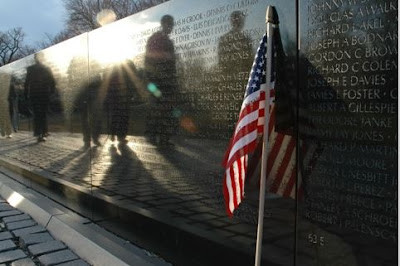Iwalked Washington D.C.’s Vietnam Veterans Memorial - “The names would become the memorial.” That is how twenty-one year old Maya Lin from Athens, Ohio described her entry to design one of the most controversial monuments for one of the most controversial wars in U.S. history. Plans for a memorial were initiated in 1979 via a former veteran from the war, Jan Scruggs. Just one year later, Congress formally approved a national monument and set aside two acres on the western portion of Constitution Gardens for its creation. More than 275,000 Americans donated $8.4 million to the cause of building the monument, of which no federal dollars were required. The monument was formally dedicated on November 11, 1993.
An anonymous submission process was used to select the winning design of the memorial. One thousand four hundred and twenty-one entries were received before entry #1026 was selected unanimously as the winner on May 1, 1981. The design came from an architecture student at Yale University who had created the design as part of her funerary architecture class during her senior year. Despite only receiving a “B” grade for her design at Yale, Lin’s design is now viewed by over three million Americans annually.
 |
| Vietnam Veterans Memorial |
Lin’s design raised some controversy at the time of its unveiling. Some described it as an open scar, while others embraced its simplicity. The memorial consists of two triangular black granite walls (quarried from Bangalore, India) that measure 246 feet and 8 inches long, and continues to grow as they converge to a height of ten feet and eleven and a half inches. The walls are set at one hundred twenty-five degree angles from each other with one wall pointed towards the Washington Monument and the other towards the Lincoln Memorial. Inscribed on each wall are the names of every American who was either killed, deemed missing in action or a taken prisoner of war.
There are currently 58,272 names etched on the wall in .53 inch font. When the wall was first constructed it contained 57,939 names. The earliest of these names dates back to 1959 with the latest added in May 2010. These individuals passed away as a result of injuries obtained during the war. There have been known instances of names that have made it onto the memorial where the person did not actually die. Up to thirty-eight potential instances have been identified where clerical errors may have contributed to this misclassification.
If you look closely at each name you will notice a symbol resides next to each one. A diamond signifies that the person died as a result of the war. A cross means that the person was either a prisoner of war or his/her status is still not officially accounted for. And in some occasions a circle has been placed around a cross demonstrating the missing person was later found alive.
Visitors are allowed to take away a rubbing of any names of family or friends. Park rangers are available to provide both commemorative paper and pencils to assist in your effort. In addition, in the event that you are unable to reach a particular name the rangers will also help you on this front as well. To find particular names, there are either books (located at each end of the memorial) or a computerized database within the information booth that provide guidance on where to look.
While many visitors are content to walk away with a remembrance from the memorial, others have been known to leave tokens of remembrance or tribute. Since 1984, the National Park Service has begun to collect each of the items left outside the memorial on a daily basis. All items are kept and maintained within the Museum Resource Center and many have been displayed within the National Museum of American History. There are said to be more than 150,000 objects left here including the likes of a Harley Davidson motorcycle and a tiger cage.
Two sculptures have been added to the Vietnam Veterans Memorial since its original unveiling. These include the Three Servicemen sculptured by Frederick E. Hart and the Vietnam Women’s Memorial by Glenna Goodacre.
- Website: http://thewall-usa.com/
- Address: Intersection of 21st Street, NW and Constitution Avenue, NW, Washington, DC
- Cost: Free
